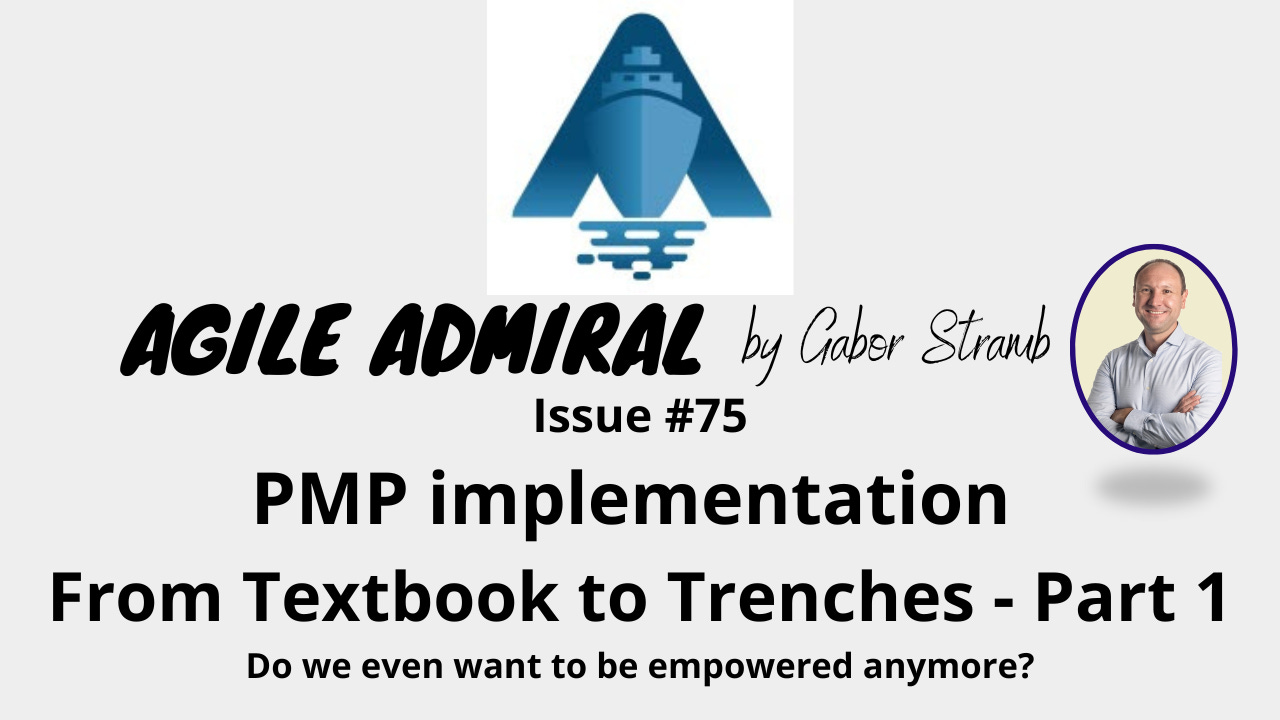PMP implementation - From Textbook to Trenches - Part 1
Do we even want to be empowered anymore?
Hey, I’m Gabor and welcome to Agile Admiral weekly newsletter. Your Essential Resource for Project Management Excellence.
Each week I tackle reader questions about PMP preparation, how to implement PMP into real-life projects and Senior Project manager career.
For more: PMP Passing Rate | Power of Lessons Learned | Agile Paradox | What Project Managers and Chefs have in common?
What's Inside This Edition:
🌟 Do we even want to be empowered anymore?
🌟 PMP implementation - From Textbook to Trenches - Part 1
Definition as per wikipedia:
Empowerment is the degree of autonomy and self-determination in people and in communities. This enables them to represent their interests in a responsible and self-determined way, acting on their own authority. It is the process of becoming stronger and more confident, especially in controlling one's life and claiming one's rights. Empowerment as action refers both to the process of self-empowerment and to professional support of people, which enables them to overcome their sense of powerlessness and lack of influence, and to recognize and use their resources.
The 10 Principles of Empowerment
Given you do need to empower our teams, but you need to operate in the era of founder mode, we've developed a different approach to building empowered teams.
We boil this down to 10 key core principles of empowerment:
End-to-end ownership
Speed as a priority
Tailored communication
Humility & vulnerability
Accountability
Clarity on impact
Ongoing mentorship
Feedback
Career development
Set moonshots
Source:
PMP implementation
"From Textbook to Trenches: How I Actually Use PMP Methodologies in My Projects" - A candid look at adapting certification principles to messy reality.
The Challenge:
Migrate a complex ecosystem of legacy systems to a modern cloud infrastructure within 12 months.
The challenge seemed daunting, but massive projects don't just happen. They are built on a foundation of structure, communication, and strategy.
As the senior project manager leading this transformation, I quickly realized that success would depend not just on technical expertise, but on a carefully orchestrated strategy that addressed both technical and organizational challenges.
Key Takeaways
1. Phased Migration with Parallel Operations
Instead of attempting a "big bang" migration, we implemented a rolling transition strategy. This involved:
- Creating a detailed dependency map of all systems
- Establishing parallel operations for critical systems
- Building reversible migration paths for each phase
- Testing rollback procedures before each major cutover
2. Risk-Based Prioritization Framework
We developed a comprehensive framework to determine migration sequence:
- Business impact analysis for each system
- Technical complexity assessment
- Integration dependencies
- Resource availability
3. Knowledge Transfer and Team Development
Success required a multi-faceted approach to capability building:
- Embedding cloud experts within legacy teams
- Creating dedicated migration pods with mixed expertise
- Implementing "migration factories" for repetitive tasks
- Establishing Centers of Excellence for key technologies
4. Stakeholder Management and Communication
We implemented a comprehensive communication strategy:
- Weekly technical steering committee meetings
- Daily operational dashboards
- Regular business impact assessments
- Proactive risk communication channels
- End-user training and support programs
Tactical Takeaway
Documentation is Your Friend: Maintain meticulous documentation of all decisions, dependencies, and changes. This becomes invaluable during complex integration phases.
Expect the Unexpected**: Build buffer time into your schedule and maintain flexible resource allocation to handle inevitable surprises.
People First**: Technical challenges are often easier to solve than people challenges. Invest heavily in training, communication, and change management.
Thank you for reading. Appreciate you!






